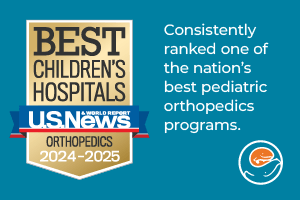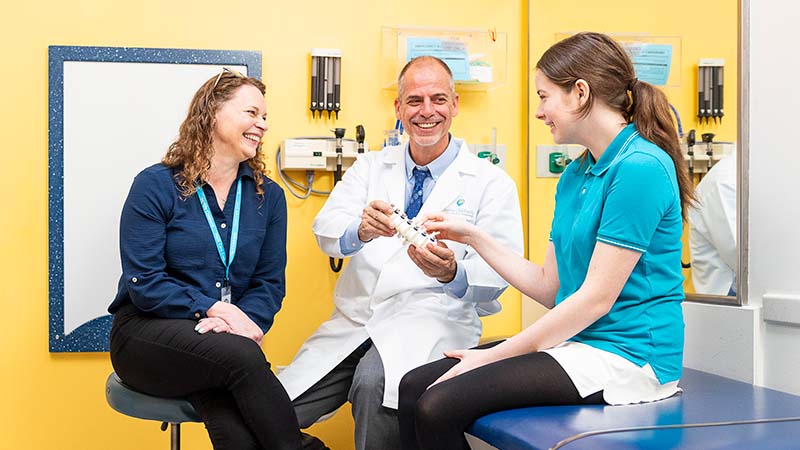Kyphosis
What is kyphosis?

Kyphosis is the forward curve in the middle of the spine. Everyone has this curve. If it gets larger than usual, it might cause symptoms, like pain.
Kyphosis (kye-FOE-sis) is the forward curve in the middle of the spine, near the ribs. Everyone has this curve. Usually, this part of the spine curves slightly, giving the back a gently rounded look. The typical range for the curve is 20 degrees to 50 degrees.
Doctors use the term kyphosis for curves that are larger than usual. You may also hear doctors call this “hyperkyphosis.”
Kyphosis is much less common than scoliosis.
Types of Kyphosis
Hyperkyphosis
Hyperkyphosis is a roundness or a hump in the middle of the back that is greater than normal.
Many teenagers slouch and look like they might have a hump. But this is not hyperkyphosis. If you ask them to stand up straight, the hump may disappear. Some doctors call this slouching “postural roundback.” Slouching often worries parents. But it has not been shown to cause any lasting change in the shape of the back.
Scheuermann kyphosis
In some rare cases, the bones of the back (vertebrae) do not grow correctly. In Scheuermann kyphosis, the front of the vertebrae does not grow as well as the back.
As your child approaches their teens, their spine grows fast. During this time, the vertebrae’s uneven growth can quickly change the shape of their back. Their back may become more curved and humped, which may cause pain.
Exercises or a back brace help some children with Scheuermann kyphosis, but most do not need any treatment. The curve is rarely big enough for doctors to recommend surgery.
Congenital kyphosis
Babies can be born with kyphosis. When the condition is present at birth (congenital), the bones in the back are shaped like wedges. Normally, these bones have a block shape. The wedge shape may cause the spine to bend sharply.
In serious cases, the sharp bend in the spine can press on the and the legs. Young children or babies with congenital scoliosis have a higher risk of spinal cord problems.
 “Being at Seattle Children’s brought us a sense of comfort. I felt like they cared about us, not just as patients, but as people.”
“Being at Seattle Children’s brought us a sense of comfort. I felt like they cared about us, not just as patients, but as people.”
— Magi, whose son Ryder had spine surgery at Seattle Children’s for a rare type of kyphosis that affects the neck
What are the symptoms of kyphosis?
In children as well as adults, kyphosis can cause a humped back. Other signs of kyphosis include:
- Back pain
- Intense tiredness (fatigue)
- Stiffness in the back
In more serious cases, kyphosis can cause problems in the heart and lungs. It may make your child more likely to get later in their back.
Spine Program at Seattle Children's
How is kyphosis diagnosed?
During your child’s visit to our clinic, we take of their spine to look for the cause of kyphosis. X-rays also help us find out what type of kyphosis your child may have.
If your child has congenital kyphosis, we usually ask them to have an . This helps us make sure the curve is not pressing on the spinal cord.
As your child grows, we will take X-rays of their spine every 6 months so we can check for changes. We take great care to use the lowest amount of radiation (PDF) we can to make the best image. We also will check your child’s function and development.
How is kyphosis treated?
At Seattle Children’s, we use both surgical and nonsurgical treatment for kyphosis. We have treated hundreds of children with this condition.
Exercises for kyphosis
In mild cases of Scheuermann kyphosis, doctors may recommend exercises to strengthen the back. This can relieve the pain and tiredness that sometimes happen when children are active. Studies have not shown that exercises affect the growth or development of the spine, though.
Back braces for kyphosis
If your child is still growing and has mild Scheuermann kyphosis, a back brace may stop the curve from getting worse. Our experienced team makes braces for children of all sizes and ages. Read about braces and our other orthotics and prosthetics services.
Surgery for kyphosis
If your child has pain from more severe kyphosis and physical therapy or bracing doesn’t help, we offer surgery.
-
Surgery to correct the curve and make the spine stable
In this surgery, the doctor will:
- Anchor screws or hooks to the bones in your child’s spine (vertebrae)
- Attach the screws or hooks to a metal rod and straighten the back
- Remove the between the bones
- Place a next to the spine to help the bones grow together (spinal fusion)
-
Thoracoscopic surgery
In severe cases, we use (thoracoscopic techniques) to release at the front of the spine. This makes your child’s spine more flexible.
In this surgery, the doctor will:
- Use special equipment to view the procedure on a monitor
- Insert tiny tools into your child’s chest through small cuts (incisions) to correct the spinal curve
- Do spinal fusion as described above
-
Surgery for congenital kyphosis
To treat congenital kyphosis, doctors often:
- Remove the problem vertebrae. They do this to relieve pressure on the spinal cord that can cause and help correct the curve.
- Correct the problem using metal rods and screws or hooks, as described above.
Why choose Seattle Children’s for kyphosis treatment?
 The Spine Program at Seattle Children’s treats all types of kyphosis in babies, children, teens and young adults. Ours is the largest pediatric spine center in the Pacific Northwest. We offer the most comprehensive care for your child, no matter how complex their condition is. It’s why other hospitals in the region refer their most complex pediatric patients to us.
The Spine Program at Seattle Children’s treats all types of kyphosis in babies, children, teens and young adults. Ours is the largest pediatric spine center in the Pacific Northwest. We offer the most comprehensive care for your child, no matter how complex their condition is. It’s why other hospitals in the region refer their most complex pediatric patients to us.
-
The experts you need are here
- The Spine Program team includes doctors, surgeons, and from Orthopedics and Sports Medicine. For more severe curves that affect the spinal cord, this team works with experts from Neurosciences.
- We can successfully treat kyphosis in most children with methods other than surgery. Nonsurgical treatment often means physical therapy or a back brace. We have the largest team of physical therapists in the Pacific Northwest who specialize in the care of babies, children, teens and young adults. We also have onsite orthotists to build and fit braces for our young patients.
- If your child needs surgery, our orthopedic spine surgeons are leaders in their field. They have more training and experience with children’s complex spine conditions than anyone else in the area. Spine surgery for children is all they do. Each is .
- We offer your child the support of an entire medical center and connect you with any expert your child may need. Based on your child’s condition, we involve specialists from across Seattle Children’s, such as the Heart Center, Pulmonary Medicine and Rehabilitation Medicine.
-
Our approach to surgery increases comfort and reduces stress
- Our new state-of-the-art operating rooms reduce stress and increase comfort for your child. The design lets you stay by your child’s side until they gently go to sleep before any spine surgery.
- Before we recommend surgery, we look at your child as a whole person. Your child’s team will take many factors into account. These include the degree of their spinal curve, the effects on their health and how much more they will grow. We also consider what results you can expect from treatment.
- We have the technology and skills to use 3D imaging to guide your child’s surgery, if needed. This helps us place hardware, such as rods and screws, with precision. It also lets us see in real time the changes we make to your child’s spine. Based on your child’s needs, we may use or .
- helps us prevent a spinal cord injury during surgery. Our surgical spinal cord monitoring team leads the country in new ways to make back surgery safer.
-
Care from birth through young adulthood
- We specialize in caring for kids. This means our experts have the knowledge, training and skills to treat the youngest patients, from babies with congenital kyphosis through young adults.
- Babies, children and teens are still developing. When we evaluate your child’s kyphosis, plan their treatment and provide their care, we carefully consider their growth. We think about how growth may affect your child’s spine over time. We also consider how their spine may affect the rest of their development and health.
- If your child needs imaging that uses radiation, we use the lowest amount possible (PDF) to make the best image. We have a low-dose radiation X-ray machine, called the EOS. It makes safer full-body images. We also have the largest group of pediatric radiologists in the Northwest.
-
Support for your whole family
- We know it can be stressful to have a child with a spinal condition and to find the treatment they need. Everyone at Seattle Children’s works to make your experience here as easy as we can on your whole family.
- Your child’s team does more than plan and provide care for your child. We also make sure you and your child understand your child’s condition and treatment options.
- Care is easier for you because your child’s team members from the Spine Program work closely with each other — and with other programs and clinics your child may need at Seattle Children’s.
- Seattle Children’s supports your family with a range of resources. Our Child Life specialists, Family Resource Center and Guest Services are here to help.
-
Research to improve care
- Members of the Spine Program team are leaders in research. We are always tracking the results of our patients’ care so we can be sure we are choosing the best treatment for each child. Your child’s care team may ask if you want to be involved in research. For example, we may ask to include data about your child’s condition and treatment in our studies.
- Our spine experts are part of national and international research groups. These groups study the latest treatment approaches and technologies. Together, we work to find the best and safest ways to care for children. We are part of the Pediatric Spine Study Group, Harms Study Group and Fox Congenital Spine Study Group.
- Learn more about current orthopedics research at Seattle Children’s.
Contact Us
Contact Orthopedics and Sports Medicine at 206-987-2109 for an appointment, a second opinion or more information.
Providers, see how to refer a patient.
Related Links
Paying for Care
Learn about paying for care at Seattle Children’s, including insurance coverage, billing and financial assistance.

